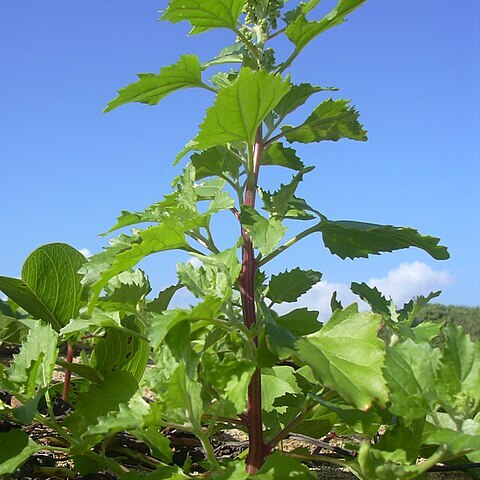Erect or ascending annuals to as much as 6 dm. tall, the branches ascending, often deeply sulcate, occasionally farinose, especially toward the extremities. Leaves somewhat lustrous and occasionally bullate above, glabrous to rather densely farinose below, deltoid to rhomb-ovate, marginally irregularly and acutely dentate, apically acuminate to attenuate and often mucronate, basally acute to truncate, 2.5-8 cm. long, 2-5 cm. broad, the petioles mostly 3-70 mm. long, sometimes quite as long as the blades. Flowers irregularly disposed in glomerules, the glomerules sessile along the dichotomously branching rhachises, these axillary and terminal, distally farinose. Sepals 5, subequal, ovate, obtuse, cucullate, 1-ribbed, slightly if at all carinate, farinose, basally connate, 1-1.5 mm. long; stamens 5, caducous, the filaments flattened, the anthers orbicular, exserted; ovary subglobose, the style quite short, the 2 (-3) stigmata ca. twice as long, spreading, irregularly glandular. Utricle partially enclosed by the sepals, the seed lenticular-cochleate, minutely tuberculate, dull reddish-brown, 1.2-1.5 mm. broad, horizontal, the pericarp adherent.
Annual, sometimes bushy herb to c. 75 cm tall, glabrous except for farina, non-aromatic, often tinged dark red. Stems strongly ascending to erect, rarely decumbent, branched, ridged. Lvs very variable in size, generally with petiole 1-2× lamina; lamina mostly 1-7-(12.5) × 0.5-6-(8) cm, rhombic-ovate, broad-triangular, sometimes farinose, usually dark green, but often distinctly reddish purple where exposed, never glaucous, coarsely and irregularly dentate-serrate; base narrow-to broad-cuneate; apex usually acute, sometimes obtuse; upper infl. lvs smaller and narrower, less deeply toothed. Infls paniculate, much-branched, terminal and axillary; branches to nearly 5 cm long, leafy nearly to apex, ± farinose; fls in rather densely crowded glomerules, farinose. Perianth segments c. 1 mm long, imbricate, bluntly keeled on back, green or reddish purple; margins hyaline. Fr. surrounded by perianth except near apex; pericarp tightly adherent. Seed horizontal, 1.1-1.5 mm diam., flattened vertically, orbicular; margin acute; testa black, minutely pitted.
Annual up to 90 cm. high, upright or spreading, normally much branched, green, rarely red-tinged, mealy especially on young parts but rarely densely so.. Leaves variable, commonly rhombic-ovate, rarely narrower, about 1.5–9 cm. long and 0.8–5 (–7) cm. wide, without any tendency for especially prominent basal lobes, but with several coarse irregular ascending usually sharp teeth (about 5–15 teeth on each margin, rarely fewer).. Inflorecences leafy, composed of divaricately branched cymes up to 5 cm. long, terminal and from upper axils.. Flowers greenish, minute, about 1–1.5 mm. in diameter.. Sepals 5, papillose on margins and outside, each with a blunt raised green keel towards apex only.. Stamens 5.. Pericarp very difficult to detach from seed.. Seeds (Fig. 2/3, p. 3) black, somewhat shining, 1.2–1.5 mm. in diameter, acutely keeled; testa under microscope marked with very close minute rounded pits.
Stems erect, branched, 1-6(-10) dm, glabrous (to sparsely farinose when young); proximal branches decumbent. Leaves nonaromatic; petiole 1-2.5 cm; blade triangular, ovate, or rhombic-ovate, 0.8-4(-8) × 0.4-3(-5) cm, base cuneate to rounded, margins irregularly dentate, apex acute to acuminate, glabrous (rarely indistinctly farinose when young). Inflorescences glomerules in terminal and lateral panicles, 6-7 × 4-5 cm; glomerules subglobose, 2-4 mm diam., or some flowers not in glomerules; bracts absent. Flowers: perianth segments 5, distinct nearly to base; lobes ovate, 0.5-0.8 × 0.6-0.7 mm, apex acute to obtuse, keeled abaxially, farinose, covering fruit at maturity; stamens 5; stigmas 2, 0.2 mm. Achenes depressed-ovoid; pericarp adherent, pustulate, becoming smooth with maturity. Seeds lenticular, round, 1-1.5 mm diam.; seed coat black, minutely rugose to ± smooth. 2n = 18.
Erect much-branched annual to 1 m high, sparsely mealy, sometimes fetid when crushed. Leaves petiolate, broadly triangular to ovate, thin, acute, coarsely dentate with slightly incurved teeth, mealy when young; lamina 2–8 cm long. Inflorescence of compact cymes in rather open panicles, axillary and terminal. Flowers bisexual or female. Tepals 5, united towards base, prominently keeled, sparsely mealy outside. Stamens 5. Pericarp prominently papillose, persistent. Seed horizontal, lenticular, 1–1.5 mm diam., prominently keeled; testa glossy, minutely pitted; embryo circular. Seed shed with surrounding perianth.
Erect, branching annual to 8 dm; lvs long-petioled, deltoid to rhombic-ovate, acute or acuminate, sharply and coarsely toothed, truncate to broadly cuneate at base, sometimes a little white-mealy, to 8 × 6 cm; infls mostly axillary, divergent, branched; cal ± white-mealy, its 5 segments inconspicuously keeled on the back; seeds adnate to the pericarp, horizontal, dull black, sharply margined, 1.2–1.5 mm wide; 2n=18. Native of Europe, intr. in waste places in our range.
Leaves variable, commonly rhombic-ovate in outline, rarely narrower, (0.7) 1.5–9 × (0.4) 0.8–5 (7) cm., without any tendency for especially prominent basal lobes, but with several coarse irregular ascending usually sharp teeth (about 5–15 on each margin, rarely fewer).
Pericarp very difficult to detach from seed. Seeds black, somewhat shining, 1.2–1.5 mm. in diam., acutely keeled; testa (seen under microscope) marked with very close minute rounded pits.
Annual up to 90 cm. high, upright or spreading, normally much branched, green, rarely red-tinged, with mealy hairs especially on young parts but rarely densely clothed.
Inflorescences leafy, composed of divericately branching cymes up to 5 cm. long, terminal and from upper and sometimes median axils.
Perianth segments 5, papillose on margins and outside, each with a blunt raised green keel towards apex only.
Minute greenish flowers in divaricately branched leafy cymes.
Annual normally much-branched herb up to 3 ft. high
Flowers greenish, minute, about 1–1.5 mm. in diam.
A herb. Check Chenopodiastrum nurale
Mostly rhombic-ovate leaves
Stamens 5.

